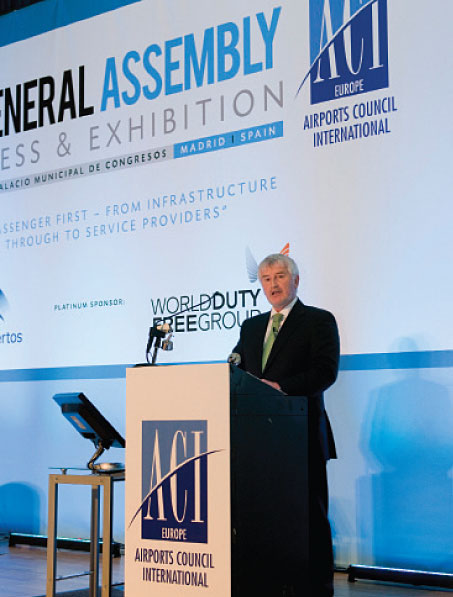
Declan Collier, CEO, London City Airport and ACI EUROPE President, highlighted a disconnect between the current economic reality and the focus of policy making. He stressed that airport competition is a reality and a level playing field is needed, particularly with regards to start-up aid given to airlines.
This year’s event was attended by around 400 delegates, representing airports, airlines, Air Navigation Service Providers, business partners, regulators and EU institutions. As usual, the event was preceded by a meeting of the ACI EUROPE Board, which included the participation of the ECAC coordinating committee composed of Directors General of Civil Aviation of several countries. A broad range of high-level speakers spoke on the central theme, taking in the myriad areas of airport activities. Europe’s airports are increasingly innovating to enhance the passenger experience and this was reflected in each of the conference sessions.
In his welcome address, Declan Collier, CEO, London City Airport and ACI EUROPE President, set the scene, referring to the current trading conditions for Europe’s airports. He explained that this is not just another recession in the usual aviation industry cycle of boom or bust. “This is about the impact of structural shifts in the global and European economy and their impact on aviation,” said Collier. “This kind of challenge cannot be treated in a business as usual manner; it requires a system-wide partnership not only within the industry, but critically it must include the active and positive participation of our policy makers and regulators.”
Collier also highlighted a disconnect between the current economic reality and the focus of policy making. He stressed that airport competition is a reality and the need for continuous public investment in airports, in the context of the forthcoming revision of the EU State Aid guidelines for the aviation sector. “What we cannot accept is the idea that Europe should cease all public financing for airport infrastructure, while the rail network gets an astonishing €42 billion of public money every year. To do so would ignore the stark economic realities facing many of Europe’s airports today not to mention that it would ignore the way airports are financed outside Europe and by doing so place Europe’s airports at a competitive disadvantage to airports in other parts of the globe,” commented Collier.
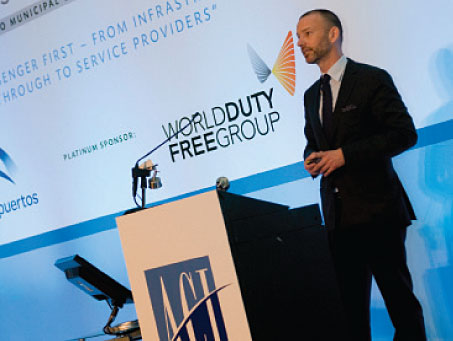
Citing the theme of ‘passenger experience’ and linking it to airport competition, ACI EUROPE Director General Olivier Jankovec highlighted that airports are embracing new technology and the digital revolution, pointing to key figures from the ACI EUROPE Digital Report.
ACI EUROPE Director General Olivier Jankovec delivered a ‘State of the Industry’ address, in which he explained that 2011 was a year of contrasted resilience with overall passenger numbers growing by +7.3%; the figures show that traffic in EU countries increased by +6.3% and in the new Europe by +11.8%. 2012, explained Jankovec, is the moment of truth. The full-year forecast is +2% growth in passengers, but a -2% decline in freight. He also addressed financial performance, emphasising that 48% of Europe’s airports are loss-making – up from 41% in 2009. Jankovec explained that Europe’s airlines are moving from being supply driven to demand driven; this means reduced route opening, increased network volatility, pressure on airport charges and converging growth rates between the low-cost and legacy carriers. Citing the theme of ‘passenger experience’ and linking it to airport competition, Jankovec highlighted that airports are embracing new technology and the digital revolution, pointing to key figures from the ACI EUROPE Digital Report.
He went on to outline the 3 key strategic directions followed by airports as part of their business evolution process: Operational & Financial Performance, Service Quality and Corporate & Social Responsibility.
Keynote addresses
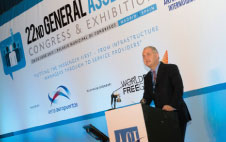
Thierry Antinori, Executive Vice President for Passenger Sales Worldwide, Emirates, delivered the ‘Industry Keynote’. He explained how the passenger experience is at the heart of the development strategy in Dubai.
The first keynote address was from Emirates. Thierry Antinori, Executive Vice President for Passenger Sales Worldwide, Emirates stood in for CEO Tim Clark, who had to cancel his appearance at the last minute. The keynote coincided with the airline’s significant capacity into the Iberian peninsula. Antinori announced a second daily flight on the Madrid-Dubai route, as well as the launch of daily operations from Dubai to Barcelona and Lisbon – each of these services was introduced in July. He explained how the passenger experience is at the heart of the development strategy in Dubai. For example, Emirates launched its Baggage Delivery Service at Dubai International Airport’s Terminal 3 last December, meaning customers no longer have to wait for their baggage on arrival. It is an initiative designed to ensure comfort and convenience for passengers. Strategically positioned immediately after the immigration counters, the service enhances the passenger experience by enabling the traveller to have their baggage delivered anywhere in the UAE on arrival at Terminal 3.
Emirates also offers self-service check-in via mobile and via kiosks, and Antinori explained that it will ultimately be the passengers that decide whether the self-service offer is expanded further. “It will depend what they want. We are a long haul airline, so our customers have baggage and will always require an element of human interaction,” he said. As part of this focus on customer service, Emirates has collaborated with Dubai Airports on the introduction of innovative ‘Information Zones’, which provide information on wayfinding and other airport services. The 40-inch LCD touch screens allow passengers to obtain directions to their gate by scanning their boarding pass.
Meanwhile, Concourse 3 – the world’s first dedicated A380 facility – will open at Dubai International Airport on 1 January 2013. The Emirates fleet currently includes 20 A380s and some 70 more are on order. The facility will boost the airport’s capacity from 60 million passengers per year to 75 million and is part of its strategy to optimise the travel experience for the increased passenger numbers.
Antinori also assured delegates of the continued importance of the European market for the airline. “There is a dynamism to Emirates in Europe. Among all of our growth areas, Europe is number one. We have 33 destinations in Europe and this year will offer 25% more seats in Europe than last year,” he commented.
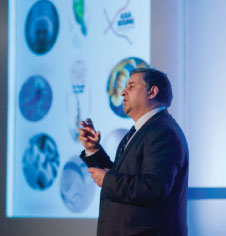
Rohit Talwar, CEO, Fast Future Research, delivered an inspirational keynote address, in which he emphasised the importance of customer engagement and personalising the airport experience in the future.
Rohit Talwar, CEO, Fast Future Research, followed with an inspirational keynote address, in which he emphasised the importance of customer engagement and personalising the airport experience in the future. He outlined the effectiveness of innovations such as Qantas’ Next Generation Check-In Program, which makes use of RFID (Radio Frequency Identification) technology to allow passengers to check-in within five-seconds, while a permanent bag tag is also offered. Talwar also heralded the manner in which airports are embracing digital media and the prevalence of airport apps, in particular highlighting Copenhagen Airport’s smartphone app, which features augmented reality. The app allows passengers to ‘scan’ the terminals using their smartphone camera. The camera will then take photographs of points of interest, such as shops and restaurants, and highlight the distance to those points and also directions to navigate to them.
Enhancing the passenger experience
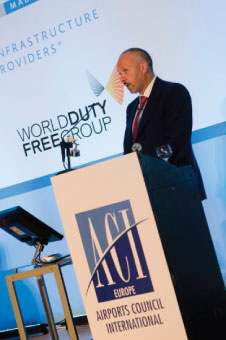
Giulio De Metrio, Chief Operating Officer & Deputy CEO, SEA Aeroporti di Milano, highlighted the innovative ViaMilano Program operated at Malpensa Airport.
The conference sessions then explored a range of subjects, including the evolution of the airport-airline relationship, improving performance and efficiencies on the ground, and providing a personalised experience and innovative commercial offer. Each session returned to the central theme of ‘Putting the passenger first’, offering a series of fresh perspectives.
Examples highlighted during the conference included the innovative ViaMilano Program operated by SEA Aeroporti di Milano. Giulio De Metrio, Chief Operating Officer & Deputy CEO, explained that it allows passengers to connect at Malpensa between carriers without an interline agreement – for example, arriving on a low-cost carrier and flying on to another destination with a full-service carrier. On arrival at Malpensa, passengers collect their luggage and hand it in to the ViaMilano transit desk; there, they receive a ViaMilano Program card that provides access to a Fast Track security lane, access to the VIP lounge, a €10 shopping voucher and free Wi-Fi access for 60 minutes.
Oliver Cussen, CEO, Dublin Airport Authority, similarly described the Airport Genie Connect product that can be used by ‘self-hubbing’ passengers at Dublin Airport. The service can be purchased for €35 for up to 6 travellers. An attendant is assigned to accompany the passenger from their arrival at Dublin Airport to the departure of their onward flight, assisting with hand luggage, accompanying them through Passport Control, into The Loop shopping area and on to the departure gate. Cussen explained that the service has significantly enhanced the passenger experience and driven up retail and F&B sales.
Jos Nijhuis, President & CEO, Schiphol Group, explained that Amsterdam Airport Schiphol is also “putting the passenger experience first”. Schiphol places great emphasis on interacting with passengers via social media and collaborated with Philips on the launch of Innovative Gate, which features lighting that can be changed depending on the brand colours of the airline using the gate. Lighting can also be used to change the ambience at the gate; for example, the lighting can be turned up when the aircraft is ready for boarding to encourage action. Passenger satisfaction is up and the feedback has been positive.
Meanwhile, Dr Harry Bush, former Group Director of Economic Regulation at the UK Civil Aviation Authority, revealed some of the key findings of a new independent Study by Copenhagen Economics – Airport Competition in Europe. A full report on the study can be found on page 17, but in summary, Dr Bush concluded that most airports in Europe are subject to competitive constraints and that there is enough evidence to question the old presumption that airports do have market power. He added that regulation should be avoided where there is sufficient competition in place.
The event also featured the Airport Investors’ Forum, which took the form of a panel discussion. Chaired by Arturo Recio, Global Head of Infrastructure, HSBC Bank plc, panellists included Craig Richmond, Regional Executive United Kingdom, Vantage Airport Group and CEO, Peel Airports; Nicolás Villén, CEO, Ferrovial Aeropuertos; Gunnar Moller, Commercial Director and Special Advisor to the Chairman of HNA Airport Group; and Michael McGhee, Partner, Global Infrastructure Partners.
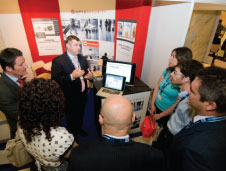
Alongside the comprehensive conference programme, the event featured a diverse exhibition of the latest technologies, products and services designed to help optimise airport operations.
The Annual Congress was an effective forum in which to share strategies and innovations designed to enhance the passenger experience, across all aspects of airport operations. It was clear throughout the conference that the central theme of ‘Putting the passenger first’ is at the forefront of the development strategies of Europe’s airports.
The Joint ACI EUROPE/ACI WORLD Annual Assembly, Congress & Exhibition, hosted by TAV Airports, will take place in Istanbul from 10 to 12 June 2013.
ACI EUROPE Best Airport Award winners 2012
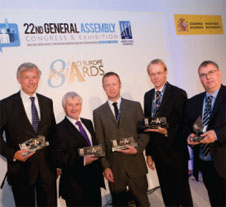
The ACI EUROPE Best Airport Award winners 2012.
The 8th annual ACI EUROPE Best Airport Awards ceremony took place at the gala dinner during the 22nd ACI EUROPE Annual Assembly, presented by Catherine Mayer Vice-President, Airport Services at SITA. This year’s judging panel featured an esteemed group of independent experts, including ACI Asia-Pacific, EUROCONTROL, ECAC and the Disabled People’s Association (Denmark).
The winners
1-5 million passengers category
Winner: London City Airport
Highly Commended: Dubrovnik Airport
5-10 million passengers category
Winner: Edinburgh Airport
Highly Commended: Alicante Airport
10-25 million passengers category
Winner: Hamburg Airport
Highly Commended: Moscow Sheremetyevo
Over 25 million passengers category
Winner: Amsterdam Airport Schiphol
Highly Commended: Barcelona El Prat
The 3rd ACI EUROPE Eco-Innovation Award – awarded by the independent Advisory Board of Airport Carbon Accreditation – went to Manchester Airport. The judges praised the airport’s outstanding environmental performance and innovative approach to environmental management. Manchester Airport’s efforts are coordinated with a wide range of stakeholders and are also supported at all levels within the organisation.







